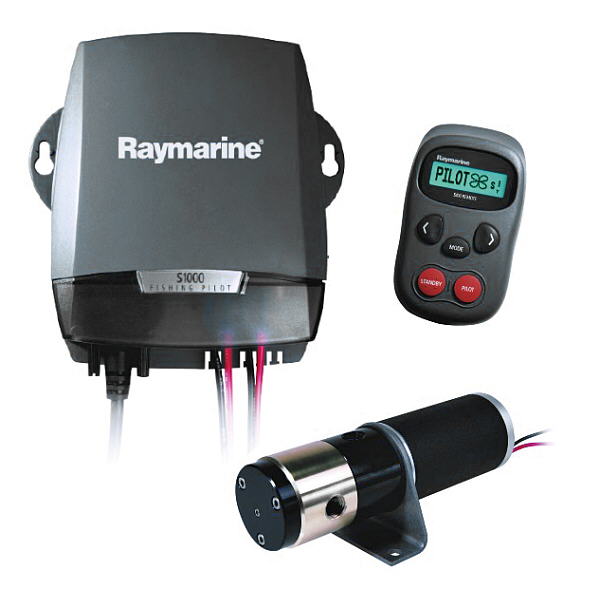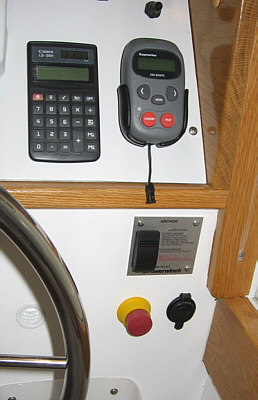|
For me one of those wants was for an autopilot. Because it did seem so much like a luxury item I was very conflicted about spending the $800 to $900 (as if the whole darn boat isn't a luxury item!). And this was a minimal system as the price could easily be three times that - see the Autopilot section of this post -Tour Page 1. After MUCH consideration I decided to make the purchase and I am writing this to offer an opinion that it was one of the best decisions I made during the build.
It must be remembered that my True Grit is a slow boat. My operational speed is usually about 7 MPH and if really in a hurry 8 MPH. This is a considerable change from all my past boating experience but I have found I am enjoying the slower relaxed pace. Still, sitting at the helm with the wheel in hand for hours on end of normally very uneventful cruising can be a little wearing. And this is where I have found for me the autopilot to be well worth the cost.
I feel a brief description of my Raymarine S1000 will help in the understanding of its use. The S1000 consist of an electronics box (about 6"x 8"x 1 1/2"), a small hydraulic pump and a handheld wireless remote about the size of a fat pack of cigarettes. The key to its lower price is it does not have all the self-contained electronics (fluxgate compass, etc.) to establish headings. For that it requires a GPS output signal. But in utilizing this it also makes other GPS features available for use. Let me explain.
There are three different methods of using the autopilot in day-to-day navigation. The first is the simplest. Set the boat on the heading you would like and push the "Pilot" button on the autopilot's remote control. The system will them look at that compass heading provided by the GPS and hold it until it is instructed to stop, which is accomplished by pressing the "Standby" button on the remote.
This works well and is very simple to use as it does a great job of tracking the compass heading. But it is not perfect. If there is a cross wind blowing the boats track will drift with the wind. The compass heading is still what was set but the intended target may be sliding off the bow to one side (I assume this is the same with any autopilot).
The only real downside to this is you can end up with a bunch of listed waypoints on the GPS that may not be useful again. So manually deleting them from the unit may be necessary. To me this is a minor inconvenience. But this method can be taken one step farther and is the mode I really enjoy.
Currently we most often cruise on Kentucky and Barkley Lakes (they are connected by a canal) in northern Kentucky. Our normal long weekend usually covers about 100 miles cruising from marina to marina or more accurately restaurant to restaurant. Prior to the trip I use mapping software to plot a "route" between the marinas. These routes consist of waypoints placed along the path I want to follow and spaced to maintain passage in what are sometimes narrow navigable channels. At times they may be placed a few miles apart and other times may be less than a 1/8 mile as needed to negotiate a tight winding river course. (Remember, routes are always made of a series of straight lines between points so short spaces are needed to form curves). I usually make several variations for each starting point. For example, from point A to point B, from point A to point C, from point A to point D.
I do this with each marina and end up with a long list of choices like point C to point F. The idea is when we leave a marina and know our destination I just activate the appropriate route on the GPS to encompass the entire trip; like point B to point H. (The GPS has the capability to reverse any of these so they can be reused on the return.) Once out of the harbor I just set the autopilot to "Track" and it will head to the first waypoint in the route. Upon arrival the remote will beep an alert and request confirmation to proceed to the next waypoint. Pressing "Pilot" allows the autopilot to make and course correction needed and proceed. On arrival at that point the process repeats.
Using this method the only input needed is the occasional push of a button as the autopilot handles the rest. I can sit back and enjoy the ride, look a magazine or read today's newspaper on my Kindle. Recently there was a four-hour stretch on the way from Kentucky Dam Marina to the Barkley State Park Marina (30 miles) where I never needed to touch the wheel. Nice!
Obviously, I must maintain a constant watch for traffic but our slow speed minimizes the number of potential conflicts. My wife is normally sitting across from me in the Admiral's seat and should I need to leave the helm for a trip to the head, refrigerator or just to get up and stretch, I hand her the remote and she continues the watch from her position.
Also, we have found at times the hot summer sun is flowing in the helm side as we are underway, making the trip somewhat uncomfortable. Normally, I set the autopilot and have my wife move to a seat in the salon and then I move to her seat. Now on the port side and in the shade I can operate the system with the remote but am still just a step away if input at the helm is needed. This is a real plus. (The photo to the right was taken on a 95 degree day as the sun blasted in on the helm.)
The system does have limitations. When wind or other boats causes the water to get choppy the hull rolling a good bit the compass heading on my GPS becomes a little erratic. This in turn causes the autopilot pump to work overtime trying to correct what are actually phantom course changes. When this happens I simply shut off the system and man the wheel until the water conditions improve. I am not sure if this is just my GPS (Lowrance LCX- 37C) or an inherent trait of all GPS units. I also am not sure if this would be a problem with conventional autopilots with a fluxgate compass but my guess is they are sufficiently dampened to minimize it. One of these days I will tap my handheld Lowrance GPS into the system and see if it makes a difference. Also, my GPS antenna head is mounted on the cabin top and I wonder if moving it to a lower location would reduce the arc movement when rolling and help the situation. Another experiment for a later date.
In conclusion, I must say I am very pleased with the somewhat expensive choice I made installing the system. It helps eliminate some of the grunt work of long runs and makes for a far more relaxing cruise. In fact, I now find myself wishing I had one on my Cabin Skiff. It really tends to spoil you!
|
 When building
a boat of this size there are many decisions to make about
equipment. Naturally, there are choices to be made on what is
"necessary" but sometimes the harder decisions involve what is NOT
necessary but desired. If money is no object the process would be much
simpler but with most of us that is not the case.
When building
a boat of this size there are many decisions to make about
equipment. Naturally, there are choices to be made on what is
"necessary" but sometimes the harder decisions involve what is NOT
necessary but desired. If money is no object the process would be much
simpler but with most of us that is not the case. To eliminate this problem, instead
of choosing a heading, use the GPS and place a waypoint at the desired
arrival location. Then with the remote change the mode from "Auto"
to "Track" and press "Pilot". The system will take a moment to look
at the waypoint and then ask you to confirm that is where you want to
go. Pressing the "Pilot" button again verifies this and the
autopilot takes over. Now even if there is crosswind navigation is
to the predetermined point and the heading will be constantly adjusted to
achieve the goal.
To eliminate this problem, instead
of choosing a heading, use the GPS and place a waypoint at the desired
arrival location. Then with the remote change the mode from "Auto"
to "Track" and press "Pilot". The system will take a moment to look
at the waypoint and then ask you to confirm that is where you want to
go. Pressing the "Pilot" button again verifies this and the
autopilot takes over. Now even if there is crosswind navigation is
to the predetermined point and the heading will be constantly adjusted to
achieve the goal.